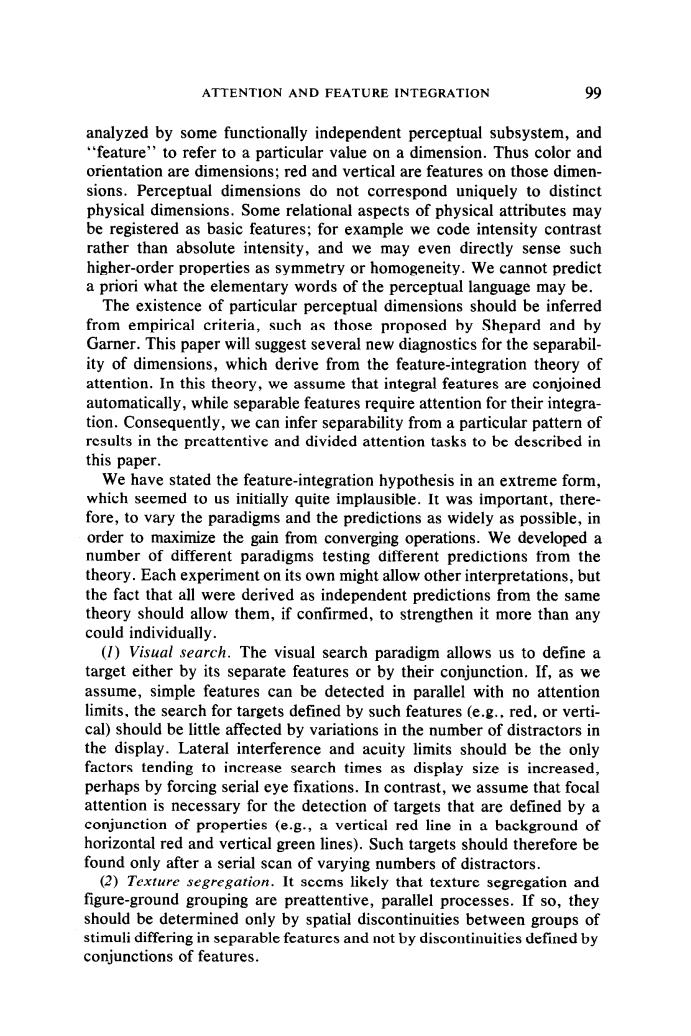正在加载图片...

ATTENTION AND FEATURE INTEGRATION 99 analyzed by some functionally independent perceptual subsystem,and "'feature to refer to a particular value on a dimension.Thus color and orientation are dimensions;red and vertical are features on those dimen- sions. Per ceptual dimension do to distinct physical dimensions Some relational aspects of physical attributes may be registered as basic features;for example we code intensity contrast rather than absolute intensity,and we may even directly sense such higher-order properties as symmetry or homogeneity.We cannot predict a priori what the e elementary words of the ptual language The existe pa r perceptual dimens from empirical criteria,such as those proposed by Shepard and by Garner.This paper will suggest several new diagnostics for the separabil- ity of dimensions.which derive from the feature-integration theory of attention.In this theory assume that integral featu are conjoined tion.Consequently,we can infer separability from a particular pattern of results in the preattentive and divided attention tasks to be described in this paper. We have stated the feature-integration hypothesis in an extreme form which s med to us initially implau It was portan th fore,to vary the par videl as pos sible,in order to max ize the gain from converging operations.We developed a number of different paradigms testing different predictions from the theory.Each experiment on its own might allow other interpretations,but the fact that all were derived as independent predictions from the same theory should alloy them if confirm d to strengthen it more than individually (1)Visual search.The visual search paradigm allows us to define a target either by its separate features or by their conjunction.If,as we assume,simple features can be detected in parallel with no attention limits.the search for t ets defined affected by vari such s(e.g or vert al)should he li ttle n the nun ors the display. Lateral interference and acuity limits should be the only factors tending to increase search times as display size is increased. perhaps by forcing serial eye fixations.In contrast,we assume that focal attention is necessary for the detection of targets that are defined by a coniunction of pron rties (e.g line in horizontal red and v gree n lines).Such should therefore be only after a serial scan of varying numbers of distractors. segregation.It scems likely that texture segregation and figure-ground grouping are preattentive,parallel processes.If so,they should be determined only by spatial discontinuities between groups of stimuli differing in separable features and not by discontinuities defined by coniunctions of features. ATTENTION AND FEATURE INTEGRATION 99 analyzed by some functionally independent perceptual subsystem, and “feature” to refer to a particular value on a dimension. Thus color and orientation are dimensions; red and vertical are features on those dimensions. Perceptual dimensions do not correspond uniquely to distinct physical dimensions. Some relational aspects of physical attributes may be registered as basic features; for example we code intensity contrast rather than absolute intensity, and we may even directly sense such higher-order properties as symmetry or homogeneity. We cannot predict a priori what the elementary words of the perceptual language may be. The existence of particular perceptual dimensions should be inferred from empirical criteria, such as those proposed by Shepard and by Garner. This paper will suggest several new diagnostics for the separability of dimensions, which derive from the feature-integration theory of attention. In this theory, we assume that integral features are conjoined automatically, while separable features require attention for their integration. Consequently, we can infer separability from a particular pattern of results in the preattentive and divided attention tasks to be described in this paper. We have stated the feature-integration hypothesis in an extreme form, which seemed to us initially quite implausible. It was important, therefore, to vary the paradigms and the predictions as widely as possible, in order to maximize the gain from converging operations. We developed a number of different paradigms testing different predictions from the theory. Each experiment on its own might allow other interpretations, but the fact that all were derived as independent predictions from the same theory should allow them, if confirmed, to strengthen it more than any could individually. (I) Visual search. The visual search paradigm allows us to define a target either by its separate features or by their conjunction. If, as we assume, simple features can be detected in parallel with no attention limits, the search for targets defined by such features (e.g., red, or vertical) should be little affected by variations in the number of distracters in the display. Lateral interference and acuity limits should be the only factors tending to increase search times as display size is increased, perhaps by forcing serial eye fixations. In contrast, we assume that focal attention is necessary for the detection of targets that are defined by a conjunction of properties (e.g., a vertical red line in a background of horizontal red and vertical green lines). Such targets should therefore be found only after a serial scan of varying numbers of distracters. (2) Texture segregation. It seems likely that texture segregation and figure-ground grouping are preattentive, parallel processes. If so, they should be determined only by spatial discontinuities between groups of stimuli differing in separable features and not by discontinuities defined by conjunctions of features